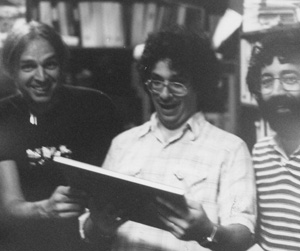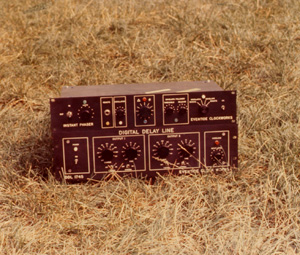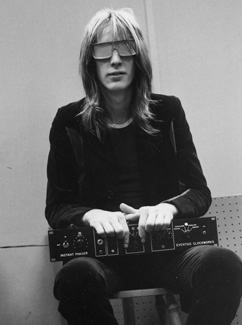Eventide Turns 40 (And Turns A Corner As Well)
When the founders of Eventide attended their first AES Convention, they brought along “a fanciful aggregation of ‘products’ [they] were unable to demonstrate due to the complete lack of any internal electronic components”. This year, they return for their fortieth as one of the most recognizable and long-lived names in professional audio. They also have a new direction – A Native software line that will put Eventide effects into more hands than ever.
When Richard Factor, Steve Katz, and Orville Greene founded Eventide in NYC just 40 years ago, digital audio barely existed. Not for any practical purposes, at least.
Even analog audio was still in its infancy in a few ways. Full-featured stereo delays had yet to be invented. The best that the engineers of the day could do was to either chain two tape machines together, fruitlessly attempt to sync a pair of Echoplexes, or try the first ever analog delay: Urei’s Cooper Time Cube.
The last of those choices was, quite literally, a garden hose in a box, with a microphone at one end and a speaker at the other. It could deliver a whopping 30 milliseconds of delay. The other available options were impractical at best.
All that began to change when Eventide released the 1745 Digital Delay Line. Co-founder Richard Factor had a knack for seeing the gaps in existing technology, and in a flash of simple-minded brilliance, dreaming up a way to fill the void.
He did this with Eventide’s pioneering delays and tape search units, and he’d go on to do it again in aviation and computing. As Eventide continued to redefine audio processing, Factor began introducing some of the first moving-map displays for private airplanes, and aftermarket RAM for DSP developers.
“Back then, I was a long-haired, weirdo, hippie freak – Like just about everybody,” Factor joked when we caught up with him for this story. “Now, I’m just a weirdo,” he laughs.
After Factor made his early innovations, it was up to the Eventide team to take the ball and run with it. Their Audio division got especially lucky when it found Tony Agnello, a grad student at New York’s City College, and a self-described “frustrated musician”.
(Tony Agnello also happens to be the big brother of John Agnello, the Producer/Engineer who’s worked with guitar-based rockers from Aerosmith and Twisted Sister to Dinosaur Jr. and Sonic Youth. Tony’s newfound connections in the audio world would help a teen-age John land to his first job as a lowly studio “gopher”.)
THE FIRST EFFECTS
“Just as I was getting into the industry, rent in the city was starting to get much more expensive,” says Tony Agnello.
“Recording studios that had dedicated entire rooms to use as echo chambers started to discover that they could buy a metal plate from EMT to get reverb, instead of wasting an entire room just to let sound bounce around between the walls.”
“The one problem with an EMT plate though, is that unlike a room, there’s no pre-delay – there’s no pause before the onset of the reverb. That tends to sound unnatural.”
And that’s where the first Eventide delays came in. With up to 200 milliseconds of delay, the earliest units were perfect for sprucing up reverb sends or for providing an easy way to achieve “Automatic Double Tracking”, known today as electronic “doubling”.
These early delay lines would also go on to revolutionize live sound systems by allowing technicians to sync distant sets of speakers for proper time-alignment. Later units even allowed broadcasters to avoid fines by affording an ample broadcast delay in which they could edit out swear words.
THE FIRST MULTI-EFFECTS
“Delays were interesting to me,” says Agnello, “but I wanted to create musical instruments.”
Pretty quickly, he would do just that.
In 1974, Agnello used the front-room of his NYC railroad apartment to single-handedly design the effect that would put Eventide on the map – not just in studio machine rooms, but on-stage, and in the ears and minds of cutting-edge musicians and creative engineers.
The Eventide 910 Harmonizer was a pitch-shifter and a delay, and it sounded unlike anything most musicians had ever heard.
Tony Visconti would use the unit to create groundbreaking drum sounds for David Bowie’s Low and Iggy Pop’s The Idiot. This and future incarnations would end up in the live and studio rigs of guitarists like Frank Zappa, Eddie Van Halen, Robert Fripp, and Peter Frampton. Agnello’s new effect box created sounds that were unheard of then, and have become iconic now.
Development continued at a rapid pace through all of Agnello’s time at Eventide, up through his departure in 1982. After working on a series of reverb lines, Agnello would go on to found a total of three other companies. He would become a designer’s designer, building tools that DSP engineers could use on their own projects. Pretty soon, his clients were physicists and MRI engineers instead of proggy arena rockers.
And as for Eventide? They’d keep one foot firmly in the studio world, while trying to keep the other foot balanced between avionics and computing.
THE PLATEAU AND EVENTUAL REJUVENATION OF EVENTIDE
Eventide remained a major force in high-end studio effects throughout the 80s and 90s.
Even as new developers produced more flexible and less expensive multi-effects, the early pioneer’s signature sounds stayed in demand. But as tectonic forces brought the old studio system to its knees, and launched a whole new musical equipment industry, Eventide just didn’t keep up with times. The once-pioneering company was floundering. The reason was a failure to innovate.
Agnello meanwhile, was fresh from a series of successes. He’d built and sold his own companies well before the dot-com bust of the early aughts, and took some time off to raise his daughters. As a hobby, he even launched Princeton Digital, an early and much-acclaimed purveyor of DAW-based plug-in effects.
When Richard Factor invited him back to Eventide to help turn the company around post-9/11, Agnello brought a team of fresh-faced young designers along. The manufacturer, which had been on the brink of calamity, slowly started to turn around.
Agnello had Eventide abandon both avionics and computing. The company saved lives in the former and broke ground in that latter, but they’d been surpassed by newer, bigger competitors who recognized growing opportunities in these fields and were better able to leverage economies of scale.
Today, Eventide is focused on its audio roots once again, and their young team is determined to continue the company’s original mission: to innovate in audio and push the boundaries of sound.
Even 40 years later, Agnello’s sharp wit and no-nonsense attitude is fully intact. But whenever he talks about the new designers who are helping Eventide turn the corner he beams. “They’re musicians, they’re passionate, they’re just brilliant and energetic.”
“The algorithms in the [1980s Eventide] 2016 used every CPU cycle,” says Agnello. The new line of pedals his young team has designed does the same.
“The only limitation has ever been the number of cycles, the available power of current DSP technology.” He says this with the kind of optimism that’s tempered by an innate pragmatic attitude. “We can see even farther than we can reach.”
What the future holds for Eventide is impossible to say. But it seems they’re already on the cusp of greater relevance as their new pedals and plug-ins win fans with today’s experimenters and innovators.
Annie Clark, the critically-acclaimed guitarist who performs as St. Vincent, counts on Eventide’s latest pedals to help her craft cunning and truly progressive new tones. And to a new generation of music-makers, the original Eventide sounds have survived enough fashion cycles to be considered modern-day classics.

While the iconic sounds of the original Eventide harmonizers, phasers, reverbs, and multi-effects were once accessible only to owners of the vintage hardware units, the company has recently entered the TDM plug-in market, and developed a slew of powerful new forward-looking effects to go along with their studio classics
Up until now, obtaining the progressive and powerful suite of Eventide plug-in has carried a premium price tag. Tomorrow, Agnello and company are set to arrive at the 131st AES convention and announce that for the first time, every user can afford access to these uniquely flexible tools.
As of 2011, Eventide is going Native.
But is it enough to help them become the first name in cutting-edge effects once again? We’ll ask them again in 2012.
Click for more on Eventide’s history and current product line. And stay tuned for our upcoming “Eventide: Reflections” feature with comments from notable early users and colleagues on the legacy of this NYC-born audio company.
Justin Colletti is a Brooklyn-based producer/engineer who works with uncommon artists, and a journalist who writes about music and how we make it. Visit him at http://www.justincolletti.com.
Please note: When you buy products through links on this page, we may earn an affiliate commission.










Synpro
October 21, 2011 at 10:45 pm (13 years ago)Hmmm…this is an interestingly skewed article and neglects to acknowledge a number of other MAJOR people who helped Eventide stay out of the “has been’s”. These include Dave Derr who went on to found Empirical Labs (anyone ever heard of something called the Distressor??) and Ken Bogdonowicz who founded Sound Toys, the creators of some of the finest plug in’s to be found on this planet. One might also consider the talents of Gill Griffith who was THE guy selling many of the Eventides great wares. Remember the H-3000, after the original Harmonizer it was THAT box that really put Eventide over the moon becoming a staple tool of artists like Brian Eno and many others.
Sergei Korolev
October 24, 2011 at 5:11 am (13 years ago)Wow, that article is quite the work of
fiction, perhaps unintentionally
if the only source is Tony.
Being the DSP Group Manager at Eventide from 1996 – 2002 I can
insert some reality …1. I find the sentence “The reason was a failure
to innovate.” flat out obscene. After Tony was fired in ’82, Ken Bogdanowicz
created the premier muti-effects box, the H3000, over ten thousand of
which were sold. The previous product, Tony’s SP2016, sold only about a
hundred copies.Following on the success of the H3000, Ken with Robert
Belcherand Laura Nass and later RB-J created the highly innovated DSP4000.
The operating system that Robert Belcher architected IS at the core of
the products Eventide makes today, pedals and plugins!Repackaging existing
algorithms and software into differenthost systems does not constitute
“innovation” in my book.2. I’m not saying anything but “built and sold”?
… Commercial Credit Report for
Ariel Corporation (United States) – Report Preview3. Not that I
would want to be associated with Princeton Digital(I was briefly) being as
it wasn’t very successful but the reissue came about as the result of work I
was doing at Eventide in 1999 to create a Stereo Room module for the
DSP4000.The actually source code for the algorithm (which was just
basedon a published article) had been lost and I had to reverse
engineerthe code from the ROMs. I contacted Tony for some input whenI
was 90 percent “there” and not much later he “got” the idea to reissue the
Stereo Room algorithm.Richard blessed it and I didn’t care ’cause it wasn’t
a major draw.Anyway, there’s more but as the saying goes “Believe
none of what you hear and half of what you see”.
Justin Colletti
October 25, 2011 at 10:36 pm (13 years ago)Thanks for your reply! For the record, the H3000 was (and is) a phenomenal effects box.
More than a few of our readers wrote in to express their fondness for the H3000, the DSP4000 and the many designs we weren’t able to feature in our brief Eventide story. I’ll be the first to admit that our story isn’t a comprehensive one. To even begin to do the complete history of the company justice would have taken at least 4,000-5,000 words rather than the 1,600 we settled on for this brief recap and overview.
For this snapshot, we decided to take a look at the company’s roots, its eventual troubles, and its current direction. We don’t have the space to list every person behind a company’s successes, but the great work done by Ken Bogdanowicz, Dave Derr, Bob Belcher, Gil Griffith and many others before the company suffered from eventual market stagnation is unforgettable, and the fact that the entire history of classic Eventide effects are now available on Native systems is itself half the point of this brief overview. It’s never our intent to dismiss great work, even if sometimes we can’t fit it all in.